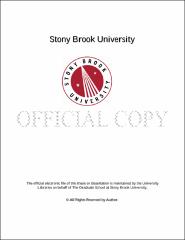| dc.identifier.uri | http://hdl.handle.net/11401/76500 | |
| dc.description.sponsorship | This work is sponsored by the Stony Brook University Graduate School in compliance with the requirements for completion of degree. | en_US |
| dc.format | Monograph | |
| dc.format.medium | Electronic Resource | en_US |
| dc.language.iso | en_US | |
| dc.publisher | The Graduate School, Stony Brook University: Stony Brook, NY. | |
| dc.type | Dissertation | |
| dcterms.abstract | Ribosomes are macromolecular machines that catalyze the fundamental process of protein synthesis in the cell. Proper proceeding of the translation process is essential for the fitness and survival of all cells. However, stalling of ribosomes occurs on aberrant mRNA transcripts that lack the necessary information for proper decoding. Persistence of such defective mRNAs leads to futile cycles of translation and sequestration of the ribosomal machinery. Bacteria have evolved a versatile translation quality control mechanism termed trans-translation. A chimeric transfer-messenger RNA (tmRNA) and its essential protein co-factor Small protein B (SmpB) are the pivotal components of this major ribosome-rescue system. As a result of the action of SmpB-tmRNA complex, stalled ribosomes undergo proper translation termination, thereby allowing recycling of the ribosomal subunits. A special hallmark of this system is the recruitment of a 3′ - 5′ exoribonuclease, RNase R, to degrade the defective mRNA on stalled ribosomes. Previous studies have shown that the distinctive C-terminal lysine-rich (K-rich) domain of RNase R is essential for defective mRNA degradation. In this thesis project, I investigated the necessary elements of the trans-translation system that are required for facilitating RNase R mediated nonstop mRNA decay. I have shown that conserved residues Glu740/Lys741 and Lys749/Lys750 present in the K-rich domain of RNase R are critical for trans-translation dependent defective mRNA decay. Through mutational analyses of tmRNA and SmpB, I have found that the decay of defective mRNA initiates after establishment of the tmRNA open reading frame (ORF) as the surrogate template, facilitated in part by the SmpB C-terminal tail. Furthermore, my investigations suggested that the putative contacts made by the ultimate and penultimate codons in the tmRNA ORF with the translation apparatus are necessary to enable RNase R to access the 3′ end of the defective mRNA. Finally, RNA-protein crosslinking and immunoprecipitation analysis revealed that RNase R binds near the mRNA exit-channel on the small ribosomal subunit for optimal capture of the emerging defective mRNA from stalled ribosomes. | |
| dcterms.available | 2017-09-20T16:50:27Z | |
| dcterms.contributor | Karzai, Wali | en_US |
| dcterms.contributor | Garcia-Diaz, Miguel | en_US |
| dcterms.contributor | Sternglanz, Rolf | en_US |
| dcterms.contributor | Bliska, James | en_US |
| dcterms.contributor | Ju, Jingfang. | en_US |
| dcterms.creator | Venkataraman, Krithika | |
| dcterms.dateAccepted | 2017-09-20T16:50:27Z | |
| dcterms.dateSubmitted | 2017-09-20T16:50:27Z | |
| dcterms.description | Department of Molecular and Cellular Biology. | en_US |
| dcterms.extent | 122 pg. | en_US |
| dcterms.format | Monograph | |
| dcterms.format | Application/PDF | en_US |
| dcterms.identifier | http://hdl.handle.net/11401/76500 | |
| dcterms.issued | 2015-08-01 | |
| dcterms.language | en_US | |
| dcterms.provenance | Made available in DSpace on 2017-09-20T16:50:27Z (GMT). No. of bitstreams: 1
Venkataraman_grad.sunysb_0771E_11890.pdf: 19734540 bytes, checksum: 2827aef2f701b084737bd869a99681be (MD5)
Previous issue date: 2014 | en |
| dcterms.publisher | The Graduate School, Stony Brook University: Stony Brook, NY. | |
| dcterms.subject | Biochemistry | |
| dcterms.subject | nonstop mRNA decay, Ribosome stalling, RNase R, SmpB, tmRNA | |
| dcterms.title | Elucidation of RNase R Mediated Nonstop mRNA Decay on Stalled Ribosomes | |
| dcterms.type | Dissertation | |

